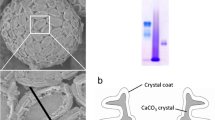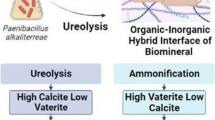Abstract
Marine coccolithophorids (Haptophyceae) produce calcified scales “coccoliths” which are composed of CaCO3 and coccolith polysaccharides (CP) in the coccolith vesicles. CP was previously reported to be composed of uronic acids and sulfated residues, etc. attached to the polymannose main chain. Although anionic polymers are generally known to play key roles in biomineralization process, there is no experimental data how CP contributes to calcite crystal formation in the coccolithophorids. CP used was isolated from the most abundant coccolithophorid, Emiliania huxleyi. CaCO3 crystallization experiment was performed on agar template layered onto a plastic plate that was dipped in the CaCO3 crystallization solution. The typical rhombohedral calcite crystals were formed in the absence of CP. CaCO3 crystals formed on the naked plastic plate were obviously changed to stick-like shapes when CP was present in the solution. EBSD analysis proved that the crystal is calcite of which c-axis was elongated. CP in the solution stimulated the formation of tabular crystals with flat edge in the agarose gel. SEM and FIB-TEM observations showed that the calcite crystals were formed in the gel. The formation of crystals without flat edge was stimulated when CP was preliminarily added in the gel. These observations suggest that CP has two functions: namely, one is to elongate the calcite crystal along c-axis and another is to induce tabular calcite crystal formation in the agarose gel. Thus, CP may function for the formation of highly elaborate species-specific structures of coccoliths in coccolithophorids.









Similar content being viewed by others
References
Billard C, Inouye I (2004) What is new in coccolithophore biology? In: Thierstein HR, Young JR (eds) Coccolithophores. From molecular processes to global impact. Springer, Berlin, pp 1–30
Bitter T, Muir HM (1962) A modified uronic acid carbazole reaction. Anal Biochem 4:330–334
Borah BM, Lakshmi H, Das G (2008) Biomimetic modulation of crystal morphology using gel: from nano to micron-scale architectures. Mater Sci Eng C 28:1173–1182
Borman AH, de Jong EW, Huizinga M, Kok DJ, Westbroek P, Bosch L (1982) The role in CaCO3 crystallization of an acid Ca2+-binding polysaccharide associated with coccoliths of Emiliania huxleyi. Eur J Biochem 129:179–183
Danbara A, Shiraiwa Y (1999) The requirement of selenium for the growth of marine coccolithophorids, Emiliania huxleyi, Gephyrocapsa oceanica and Helladosphaera sp. (Prymnesiophyceae). Plant Cell Physiol 40:762–766
de Jong E, van Rens L, Westbroek P, Bosch L (1979) Biocalcification by the marine alga Emiliania huxleyi (Lohmann) Kamptner. Eur J Biochem 99:559–567
de Vrind-de Jong EW, de Vrind JPM (1997) Algal deposition of carbonates and silicates. In: Geomicrobiology: interactions between microbes and minerals. Mineralogical Society of America, Washington, pp 267–307
Didymus JM, Oliver P, Mann S, De Vries AL, Hauschka PV, Westbroek P (1993) Influence of low-molecular-weight and macromolecular organic additives on the morphology of calcium carbonate. J Chem Soc Faraday Trans 89:2891–2900
Fichtinger-Schepman AMJ, Kamerling JP, Versluis C, Vliegenthart JFG (1981) Structural studies of the methylated, acidic polysaccharide associated with coccoliths of Emiliania huxleyi (Lohmann) Kamptner. Carbohydr Res 93:105–123
Helbig U (2008) Growth of calcium carbonate in polyacrylamide hydrogel: investigation of the influence of polymer content. J Cryst Growth 310:2863–2870
Henriksen K, Stipp SLS, Young JR, Marsh ME (2004) Biological control on calcite crystallization: AFM investigation of coccolith polysaccharide function. Am Mineral 89:1709–1716
Hirokawa Y, Fujiwara S, Suzuki M, Akiyama T, Sakamoto M, Kobayashi S, Tsuzuki M (2008) Structural and physiological studies on the storage β-polyglucan of haptophyte Pleurochrysis haptonemofera. Planta 227:589–599
Hodge JE, Hofreiter BT (1962) Determination of reducing sugars and carbohydrates. In: Methods in carbohydrate chemistry Vol. I. Academic, New York, pp 380–394
Hosoda N, Kato T (2001) Thin-film formation of calcium carbonate crystals: effects of functional groups of matrix polymers. Chem Mater 13:688–693
Kayano K, Shiraiwa Y (2009) Physiological regulation of coccolith polysaccharide production by phosphate availability in the coccolithophorid Emiliania huxleyi. Plant Cell Physiol 50:1522–1531
Li H, Estroff LA (2007) Hydrogels couples with self-assembled monolayers: an in vitro matrix to study calcite biomineralization. J Am Chem Soc 129:5480–5483
Mann S, Sparks NHC (1988) Single crystal nature of coccoliths elements of the marine alga Emiliania huxleyi as determined by electron diffraction and high resolution electron microscopy. Proc Royal Soc Lond B234:441–453
Marsh ME (2003) Regulation of CaCO3 formation in coccolithophores. Comp Biochem Physiol Part B 136:743–754
Marsh ME, Dickinson DP (1997) Polyanion-mediated mineralization—mineralization in coccolithophore (Pleurocrysis carterae) variants which do not express PS2, the most abundant and acidic mineral-associated polyanion in wild-type cells. Protoplasma 199:9–17
Marsh ME, Chang D, King GC (1992) Isolation and characterization of a novel acidic polysaccharide containing tartrate and glyoxylate residues from the mineralized scales of a unicellular coccolithophorid alga Pleurochrysis carterae. J Biol Chem 267:20507–20512
Marsh ME, Ridall AL, Azadi P, Duke PJ (2002) Galacturomannan and Golgi-derived membrane linked to growth and shaping of biogenic calcite. J Struct Biol 139:39–45
Meldrum FC, Colfen H (2008) Controlling mineral morphologies and structures in biological and synthetic systems. Chem Rev 108:4332–4432
Ozaki N, Okazaki M, Kogure T, Sakuda S, Nagasawa H (2004) Structural and functional diversity of acidic polysaccharides from various species of coccolithophorid algae. Thalassas 20:59–68
Ozaki N, Sakuda S, Nagasawa H (2007) A novel highly acidic polysaccharide with inhibitory activity on calcification from the calcified scale “coccolith” of a coccolithophorid alga, Pleurochrysis haptonemofera. Biochem Biophys Res Commun 357:1172–1176
Paasche E (2002) A review of the coccolithophorid Emiliania huxleyi (Prymnesiophyceae), with particular reference to growth, coccolith formation, and calcification–photosynthesis interactions. Phycologia 40:503–529
Saruwatari K, Ozaki N, Nagasawa H, Kogure T (2006) Crystallographic alignment of coccolith (Pleurochrisis carterae) revealed by electron back-scattered diffraction (EBSD). Am Mineral 91:1937–1940
Saruwatari K, Ozaki N, Nagasawa H, Kogure T (2008) Comparison of crystallographic orientations between living (Emiliania huxleyi and Gephyrocapsa oceanica) and fossil (Watznaueria barnesiae) coccoliths using electron microscopes. Am Mineral 93:1670–1677
Sugawara A, Nishimura T, Yamamoto Y, Inoue H, Nagasawa H, Kato T (2006) Self-organization of oriented calcium carbonate/polymer composites: effects of a matrix peptide isolated from the exoskeleton of a crayfish Angew. Chem Int Ed 45:2876–2879
Watanabe J, Akashi M (2008) An electrophoretic approach provides tunable mineralization inside agarose gels. Cryst Growth Des 8:478–482
Westbroek P, de Jong EW, Dam W, Bosch L (1973) Soluble intracrystalline polysaccharides from coccoliths of Coccolithus huxleyi (Lohmann) Kamptner (I). Calc Tissue Res 12:227–238
Wiedmer SK, Cassely A, Hong MF, Novotny MV, Riekkola ML (2000) Electrophresis 21:3212–3219
Yamamoto Y, Nishimura T, Sugawara A, Inoue H, Nagasawa H, Kato T (2008) Effects of peptides on CaCO3 crystallization: mineralization properties of an acidic peptide isolated from exoskeleton of crayfish and its derivatives. Cryst Growth Des 8:4062–4065
Yang M, Stipp SL, Harding J (2008) Biological control on calcite crystallization by polysaccharides. Cryst Growth Des 8:4066–4074
Young JR, Bergen JA, Bown PR, Burner JA, Fiorentino A, Jordan RW, Kleijne A, Van Niel BE, Ton Romein AJ, Von Salis K (1997) Guidelines for coccoliths and calcareous nannofossil terminology. Paleontology 40:875–912
Young JR, Davis SA, Bown PR, Mann SJ (1999) Coccolith ultrastructure and biomineralization. Struct Biol 126:195–215
Acknowledgment
The authors are grateful to Dr. Iwane Suzuki for his continuous help and valuable discussion during this study. This study was supported in part by the Global Environment Research Fund from the Japanese Ministry of Environment (FY2008-10; F-083) to YS.
Author information
Authors and Affiliations
Corresponding author
Rights and permissions
About this article
Cite this article
Kayano, K., Saruwatari, K., Kogure, T. et al. Effect of Coccolith Polysaccharides Isolated from the Coccolithophorid, Emiliania huxleyi, on Calcite Crystal Formation in In Vitro CaCO3 Crystallization. Mar Biotechnol 13, 83–92 (2011). https://doi.org/10.1007/s10126-010-9272-4
Received:
Accepted:
Published:
Issue Date:
DOI: https://doi.org/10.1007/s10126-010-9272-4




